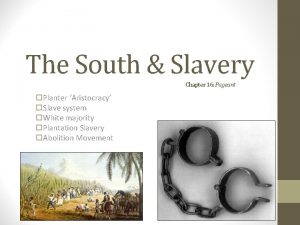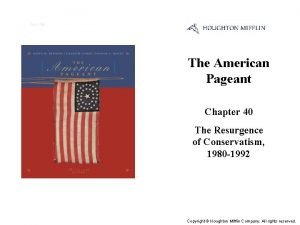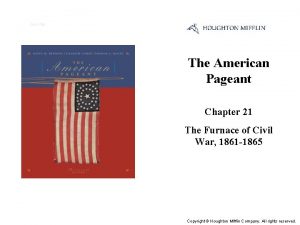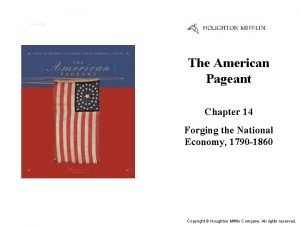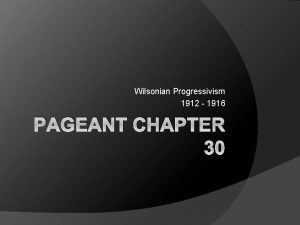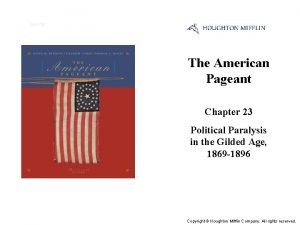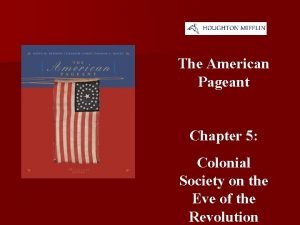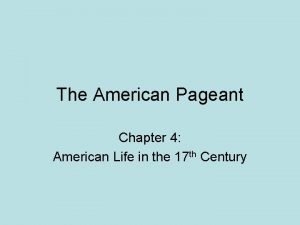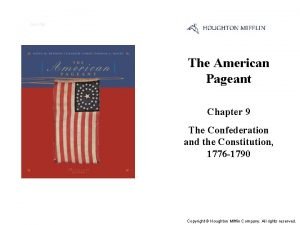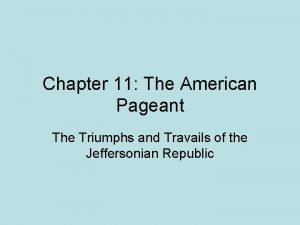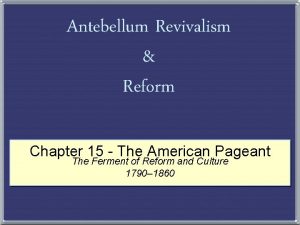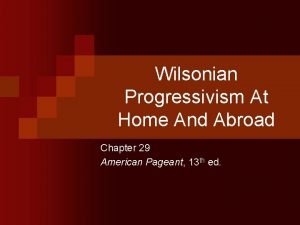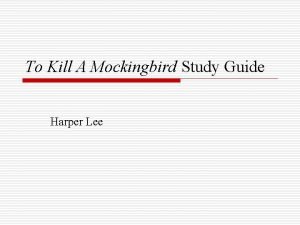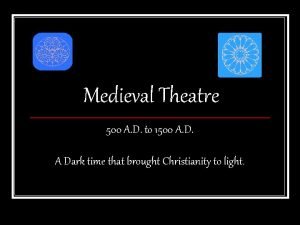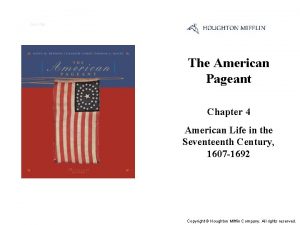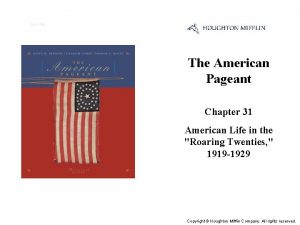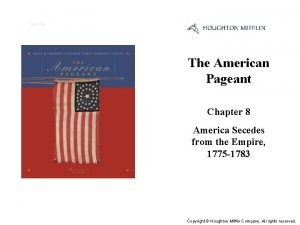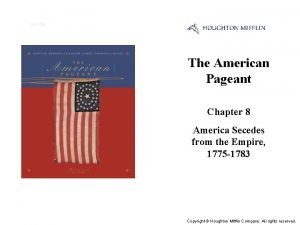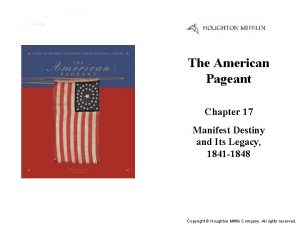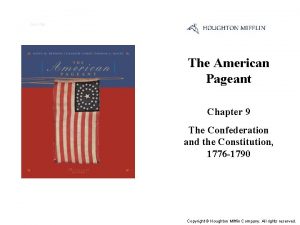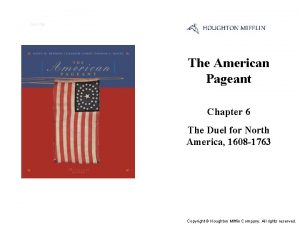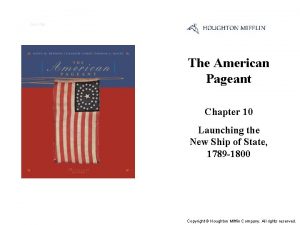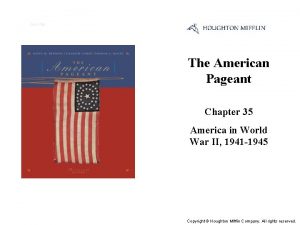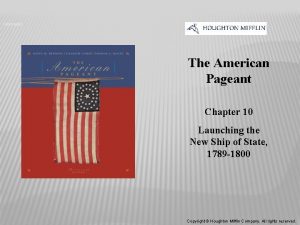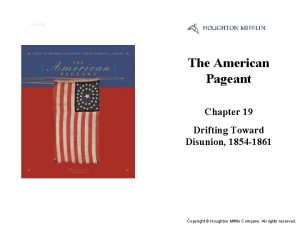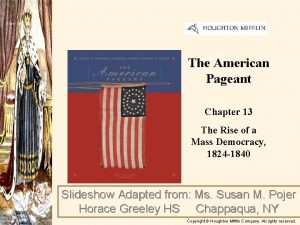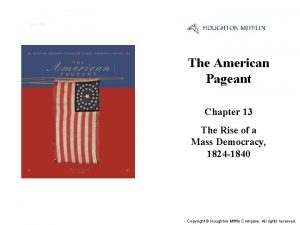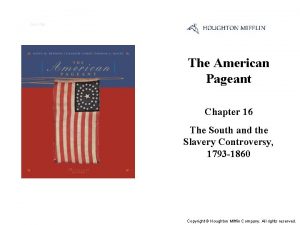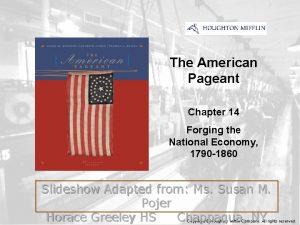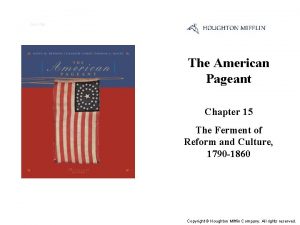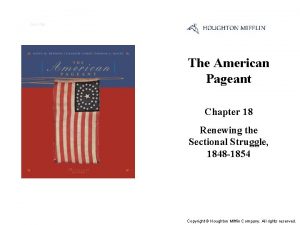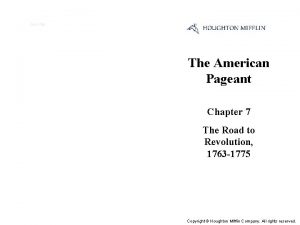Cover Slide The American Pageant Chapter 2 The





































- Slides: 37

Cover Slide The American Pageant Chapter 2 The Planting of English America, 1500 -1733 Copyright © Houghton Mifflin Company. All rights reserved.

England’s Imperial Stirrings • • • 1600 - North America largely unclaimed – Spanish had much control in Central and South America. Spain – Santa Fe- 1610 France – Quebec -1608 Britain – Jamestown- 1607 1500 s - Britain failed to effectively colonize due to internal conflicts – King Henry VIII • broke with the Roman Catholic Church • launched the English Protestant Reformation – Elizabeth I became queen • Britain became Protestant • rivalry with Catholic Spain intensified – Ireland, the • Catholics sought Spain’s help in revolt against England • English crushed the uprising with brutal atrocity, and developed an attitude of sneering contempt for natives

Elizabeth Energizes England • • • Francis Drake – Knighted by Elizabeth I after pirated Spanish ships for gold then circumnavigated the globe – This reward angered the Spanish who sought revenge English attempts at colonization in the New World failed embarrassingly – Sir Walter Raleigh and the Roanoke Island Colony, better known as “The Lost Colony” Spain attacked Britain but lost in the Spanish Armada’s defeat of 1588 – Opened the door for Britain to cross the Atlantic – Swarmed to America – Took over the lead in colonization and power – Victory also fueled England to new heights due to… • Strong government/popular monarch, more religious unity, a sense of nationalism • Golden age of literature (Shakespeare) • Beginning of British dominance at sea (which lasts until U. S. tops them, around 1900) – Britain and Spain finally signed a peace treaty in 1604

England on the Eve of the Empire • • • 1500 s – Britain’s population was mushrooming New policy of enclosure (fencing in land) for farming – Less or no land for the poor Woolen districts fell upon hard times economically – Workers lost jobs Tradition of primogeniture = 1 st born son inherits ALL father’s land – Younger sons of rich folk (who couldn’t inherit money) tried their luck with fortunes elsewhere, like America 1600 s, the – Joint-stock company was perfected (investors put money into the company with hopes for a good return)

England Plants the Jamestown Seedling • • • 1606 - Virginia Company received a charter from King James I – To make a settlement in the New World – Joint-stock companies did not exist long • Stockholders invested hopes to form the company, turn a profit, and then quickly sell for profit a few years later Charter of the Virginia Company – Guaranteed settlers the same rights as Englishmen in Britain May 24, 1607 - 100 English settlers disembarked from their ship & founded Jamestown – Forty colonists perished during the voyage – Problems emerged • The swampy site of Jamestown meant poor drinking water and mosquitoes causing malaria and yellow fever • Men wasted time looking for gold rather than doing useful tasks (digging wells, building shelter, planting crops) • There were zero women on the initial ship – Supply shipwrecked in the Bahamas (1609)

England Plants the Jamestown Seedling • • 1608 - Captain John Smith took over control and whipped the colonists into shape. – Kidnapped by local Indians • forced into a mock execution by the chief Powhatan • “saved” by Powhatan’s daughter, Pocahontas – Meant to show that Powhatan wanted peaceful relations with the colonists – John Smith’s main contribution • gave order and discipline, – highlighted by his “no work, no food” policy Colonists had to eat cats, dogs, rats, even other people – One fellow wrote of eating “pickled wife” 1610 - a relief party – headed by Lord De La Warr – arrived to alleviate the suffering 1625 - out of 8, 000 would-be settlers, only 1, 200 had survived

Cultural Clash in the Chesapeake • Powhatan considered the new colonists potential allies – tried to be friendly with them – colonists raided Indian food supplies – relations deteriorated – war occurred De La Warr used: “Irish tactics” • • First Anglo-Powhatan War ended in 1614 – peace settlement sealed by the marriage of Pocahontas to colonist John Rolfe – Rolfe & Pocahontas nurtured a favorable flavor of sweet tobacco 1622 - the Indians struck again – series of attacks that left 347 settlers, including John Rolfe, dead Second Anglo-Powhatan War began in 1644, ended in 1646 – banished the Chesapeake Indians from their ancestral lands Settlers began to grow their own food – Indians were useless – therefore banished

Virginia: Child of Tobacco • • • Jamestown’s gold is found – tobacco – Rolfe’s sweet tobacco • sought as a cash crop by Europe • Jamestown had found its gold – Tobacco created a greed for land • it heavily depleted the soil • ruined the land Representative self-government – born in Virginia – 1619 created the House of Burgesses, a committee to work out local issues – set America on a self-rule pathway First African Americans arrive in America – 1619 – unclear if they were slaves or indentured servants

Maryland: Catholic Haven • • Religious Diversity – Founded in 1634 by Lord Baltimore – Maryland • Second plantation colony • Fourth overall colony to be formed – Founded to be a place for persecuted Catholics to find refuge (a safe haven) – Lord Baltimore • Gave huge estates to his Catholic relatives • Poorer people who settled there where mostly Protestant • Created friction Maryland prospered with tobacco A lot of indentured servants – 1600 s (in Maryland Virginia) • Black slavery begin to become popular Maryland’s statute – Act of Toleration • Guaranteed religious toleration to all Christians • Decreed the death penalty to Jews and atheists and others who didn’t believe in the divinity of Jesus Christ

The West Indies: Way Station to Mainland America • • • British – colonizing Virginia – settling into the West Indies Mid-1600 s – England secured claim to several West Indies islands, including Jamaica in 1655 Grew lots of sugar on brutal plantations Slaves – needed to operate sugar plantations. At first, – Indians were intended to be used, but disease killed an estimated 90% of all Native Americans – Thousands of Africans were brought in “Codes” were set up – To control the slaves – Defined the legal status of slaves – The rights of the masters – Typically strict and exacted severe punishments for offenders

Colonizing the Carolinas • • England – King Charles I had been beheaded – Oliver Cromwell ruled for ten very strict years – restored Charles II to the throne in “The Restoration” Bloody period had interrupted colonization but after began the “restoration colonies” Carolina was – named after Charles II – formally created in 1670 – flourished by developing close economic ties with the West Indies – original Carolina settlers had come from Barbados • brought in the strict “Slave Codes” for ruling slaves – Indians as slaves was protested, but slaves were sent to the West Indies and New England to work – Rice emerged as the principle crop • African slaves were hired to work on rice plantations, due to – resistance to malaria and just as importantly – familiarity with rice Violence with Spanish and Indians – Carolina proved to be too strong to be wiped out

The Emergence of North Carolina • • • Newcomers to Carolina were “squatters” – people who owned no land – usually down from Virginia North Carolinians – developed a strong resistance to authority – due to geographic isolation from neighbors Two “flavors” of Carolinians developed: – aristocratic and wealthier down south around Charleston and rice & indigo plantations – strong-willed and independent-minded up north on small tobacco farms 1712 – North and South Carolina were officially separated 1711 – Tuscarora Indians attacked North Carolina – Carolinians responded by crushing the opposition, selling hundreds to slavery and leaving the rest to wander north, eventually becoming the Sixth Nation of the Iroquois

Late-Coming Georgia: The Buffer Colony • • • Georgia – intended to be a buffer between the British colonies and the hostile Spanish settlements in Florida – enemy French in Louisiana. 1733 - founded last by a high-minded group of philanthropists – mainly James Oglethorpe Named after King George II – second chance site for wretched souls in debt James Oglethorpe, the ablest of the founders and a dynamic soldier-statesman, repelled Spanish attacks – He saved “the Charity Colony” by his energetic leadership and by using his own fortune to help with the colony All Christians, except Catholics, enjoyed religious toleration, and many missionaries came to try to convert the Indians – John Wesley was one of them, and he later returned to England founded Methodism Georgia grew very slowly

The Plantation Colonies • • • Slavery was found in all the plantation colonies The growth of cities was often stunted by forests The establishment of schools and churches was difficult due to people being spread out In the South, the crops were tobacco and rice, and some indigo in the tidewater region of SC All the plantation colonies permitted some religious toleration Confrontations with Native Americans were often

Makers of America: The Iroquois • • • New York State - the Iroquois League (AKA the Iroquois Confederation) once a great power – Mohawks, the Oneidas, the Onondagas, the Cayugas, and the Senecas – Vied with neighboring Indians and later French, English, and Dutch for supremacy The longhouse was the building block of Iroquois society – Only 25 feet wide, but over 200 feet long, longhouses were typically occupied by a few blood-related families (on the mother’s side) The Mohawks were middlemen with European traders The Senecas were fur suppliers The Five Nations of the Iroquois’ rivals, the neighboring Hurons, Eries, and Petuns, were vanquished Throughout the 1600 s and 1700 s, the Iroquois allied with the British and French (whichever was more beneficial) American Revolution - the question of with whom to side was split. Most sided with the British, but not all Iroquois were forced to reservations - proved to be unbearable to these proud people Iroquois - Handsome Lake arose to warn his tribe’s people to mend their ways – His teachings live today in the form of the longhouse religion

Armada Portrait of Elizabeth I Queen Elizabeth I used her charm and intelligence to turn England into a major world power. This portrait, painted around 1588 when Elizabeth was 55 years old, shows the queen at the peak of her power, a fact depicted by the artist in the scenes visible through the windows in the background. Through the left window, we can see Elizabeth's naval fleet; through the right one, we witness the Spanish Armada sinking in the stormy Atlantic. (By kind permission of the Marquess of Tavistock and Trustees of the Bedford Estate) Copyright © Houghton Mifflin Company. All rights reserved.

Bartholomew Gosnold Trading with Indians at Martha's Vineyard by Theodor de Bry, 1634 This picture shows one interpretation of a trading session between the English and Native Americans. Theodor de Bry was one of the first to include such drawings in his accounts of the New World. Previous works on the subject contained either no illustrations or very crude ones. (Library of Congress) Copyright © Houghton Mifflin Company. All rights reserved.

Depiction of Racial Mixtures by Miguel Cabrera One of the few extant depictions of a mixed-race family in eighteenth-century North America, by the Mexican artist Miguel Cabrera, 1763. The Spanish father and Indian mother have produced a mestiza daughter. Families such as this would have been frequently seen in New Mexico as well. (Private Collection ) Copyright © Houghton Mifflin Company. All rights reserved.

Jamestown skeleton In 1996, archeologists working at Jamestown uncovered this skeleton of a young man they nicknamed "JR. " JR was a European male, 5' 6" tall, between the ages of 19 and 22. We know that he bled to death from a bullet wound in his leg, but we don't know the circumstances of his death. Was he a gentleman, shot for treason? Was he a soldier? Was he perhaps a co-conspirator with Captain John Smith in Smith's mutiny attempt at sea? The answer remains a mystery, but JR's discovery illustrates how much early American historians have come to rely upon archeologists for help in reconstructing the colonial past. (Kenneth K. Lyons/Newport News Daily Press) Copyright © Houghton Mifflin Company. All rights reserved.

John White's drawings of Indians fishing John White, an artist with Raleigh's 1585 expedition (and later the governor of the ill-fated 1587 colony), illustrated three different fishing techniques used by Carolina Indians: to the left, the construction of weirs and traps; in the background, spearfishing in shallow water; and in the foreground, fishing from dugout canoes. The fish are accurately drawn and can be identified today. (Trustees of the British Museum) Copyright © Houghton Mifflin Company. All rights reserved.

Nathaniel Bacon came to Virginia as a gentleman in the 1670 s, but his resentment of the economic and political domination of the colony by a small group of planters transformed him into a backwoods rebel. In 1676, Bacon led an army of discontented farmers, servants, and slaves against the powerful coastal planters--and almost won. In this stained glass window, discovered and restored in the twentieth century, Bacon's social class and his commanding presence are both evident. (The Association for the Preservation of Virginia Antiquities at Bacon's Castle, Library of Virginia) Copyright © Houghton Mifflin Company. All rights reserved.

Native American Planting Maize, from Folio 121 from Histoire Naturelles Des Indes Maize (corn), which was genetically engineered by Native Americans in what is now Mexico some 7, 000 years ago, became one of the staple food sources for many Indian groups in North America. This sixteenth-century illustration depicts traditional Native American agricultural practices and typical foods including corn, squashes, and gourds. (The Pierpont Morogan Library/Art Resource, New York) Copyright © Houghton Mifflin Company. All rights reserved.

Native American Women Planting Crops in Florida by Jacques Le Moyne, an artist accompanying the French settlement in Florida in the 1560 s, produced some of the first European images of North American peoples. His depiction of native agricultural practices shows the sexual division of labor: men breaking up the ground with fishbone hoes before women drop seeds into the holes. But Le Moyne's version of the scene cannot be accepted uncritically: unable to abandon a European view of proper farming methods, he erroneously drew plowed furrows in the soil. (John Carter Brown Library at Brown University) Copyright © Houghton Mifflin Company. All rights reserved.

New Amsterdam Unlike Amsterdam, its parent city, this small colonial port had only a few homes crowding the tip of the island during the early 1600 s. However, New Amsterdam became an important strategic location for Dutch trading. A few of the mother country's largest ships brought colonists much-needed goods each year, while colonial merchants waited anxiously to exchange furs and timber. (Library of Congress) Copyright © Houghton Mifflin Company. All rights reserved.

Map: Chesapeake Expansion, 1607 -1700 The Chesapeake colonies expanded slowly before mid-century. By 1700 Anglo-Indian wars, a rising English population, and an influx of enslaved Africans permitted settlers to spread throughout the tidewater. Copyright © Houghton Mifflin Company. All rights reserved.

Map: Early Chesapeake Settlement This map shows the location of both Indian and English colonial settlements in the early seventeenth century. As the English communities grew in number and size, conflicts between the Indians of the Powhatan Confederacy and the colonists also grew, eventually leading to warfare and considerable loss of life. Copyright © Houghton Mifflin Company. All rights reserved.

Map: English Migration, 1610 -1660 During the first phase of English transatlantic migration, the West Indies attracted more than twice as many colonists as went to the Chesapeake, and over four times as many settled in New England. Copyright © Houghton Mifflin Company. All rights reserved.

Map: European Colonization in the Middle and North Atlantic, c. 1650 North of Spanish Florida, four European powers competed for territory and trade with Native Americans in the early seventeenth century. Swedish and Dutch colonization was the foundation upon which England's middle colonies were built. Copyright © Houghton Mifflin Company. All rights reserved.

Map: European Explorations in America In the century following Columbus's voyages, European adventurers explored the coasts and parts of the interior of North and South America. Copyright © Houghton Mifflin Company. All rights reserved.

Map: European Imperial Claims and Settlements in Eastern North America, 1565 -1625 By 1625 four European nations contended for territory on North America's Atlantic coast. Except for St. Augustine, Florida, all settlements established before 1607 had been abandoned by 1625. Copyright © Houghton Mifflin Company. All rights reserved.

Map: European Settlements and Indians, 1754 By 1754, Europeans had expanded the limits of the English colonies to the eastern slopes of the Appalachian Mountains. Few independent Indian nations still existed in the East, but beyond the mountains they controlled the countryside. Only a few widely scattered English and French forts maintained the Europeans' presence there. Copyright © Houghton Mifflin Company. All rights reserved.

Map: Land Divisions in Sudbury, Massachusetts, 1639 -1656 Early New England towns sought to heighten communalism by clustering homes around a meetinghouse and a town commons (used for grazing). Sudbury, like many towns, followed an English practice of distributing croplands in scattered strips. John Goodnow, for example, grew crops in five fields at varying distances from his house. Copyright © Houghton Mifflin Company. All rights reserved.

Map: New England Colonies The most densely settled region of the mainland was New England, where English settlements and Indian villages existed side by side. Copyright © Houghton Mifflin Company. All rights reserved.

Map: New Mexico, c. 1680 In 1680, the lone Spanish settlement at Santa Fe was surrounded and vastly outnumbered by the many Pueblo villages nearby. Copyright © Houghton Mifflin Company. All rights reserved.

Map: Pattern of Settlement in Surry County, Virginia, 1620 -1660 In contrast to New Englanders, Chesapeake colonists spread out along the banks of rivers and creeks. Copyright © Houghton Mifflin Company. All rights reserved.

Map: The Indian Confederacies This map shows the three major Indian military and political coalitions--the Huron, Iroquois, and Creek confederacies. Unlike the squabbling English mainland colonies, these Indian tribes understood the value of military unity in the face of threats to their land their safety and the importance of diplomatic unity in negotiating with their European allies. Copyright © Houghton Mifflin Company. All rights reserved.

Map: Western Africa and the Atlantic Slave Trade Africa's western shore was the major source for slaves that were transported to European colonies on the Atlantic islands, the Caribbean islands, and mainland North and South America. Powerful coastal kingdoms mounted organized raids into many inland areas to capture people who were then marched to the coast for shipment to the New World. This map and the accompanying table show the several regions from which slaves were extracted and give approximate numbers of people who were exported from each. Copyright © Houghton Mifflin Company. All rights reserved.
 American pageant chapter 16
American pageant chapter 16 The american pageant chapter 35
The american pageant chapter 35 Chapter 40 american pageant
Chapter 40 american pageant The american pageant chapter 21
The american pageant chapter 21 Chapter 14 american pageant
Chapter 14 american pageant American pageant chapter 13
American pageant chapter 13 The american pageant chapter 30
The american pageant chapter 30 The american pageant chapter 23
The american pageant chapter 23 American pageant chapter 34
American pageant chapter 34 American pageant chapter 5
American pageant chapter 5 Chapter 4 american pageant
Chapter 4 american pageant Chapter 9 the american pageant
Chapter 9 the american pageant American pageant chapter 11
American pageant chapter 11 American pageant chapter 15
American pageant chapter 15 American pageant chapter 41
American pageant chapter 41 Chapter 29 wilsonian progressivism at home and abroad
Chapter 29 wilsonian progressivism at home and abroad Heel toe polka music
Heel toe polka music Six cardinal fields of gaze
Six cardinal fields of gaze Cover uncover test vs alternating cover test
Cover uncover test vs alternating cover test Cover uncover test vs alternating cover test
Cover uncover test vs alternating cover test The best christmas pageant ever chapter 2
The best christmas pageant ever chapter 2 The best christmas pageant ever chapter 1
The best christmas pageant ever chapter 1 Cover slide pitch deck
Cover slide pitch deck Cover slide
Cover slide Who scares the finch children on the way to the pageant?
Who scares the finch children on the way to the pageant? The best christmas pageant ever novel study
The best christmas pageant ever novel study Medieval theatre timeline
Medieval theatre timeline Mansions medieval theatre
Mansions medieval theatre The best christmas pageant ever trailer
The best christmas pageant ever trailer Factoring slide and divide
Factoring slide and divide American dad slide
American dad slide Chapter 18 preparing for the world of work
Chapter 18 preparing for the world of work Hình ảnh bộ gõ cơ thể búng tay
Hình ảnh bộ gõ cơ thể búng tay Ng-html
Ng-html Bổ thể
Bổ thể Tỉ lệ cơ thể trẻ em
Tỉ lệ cơ thể trẻ em Gấu đi như thế nào
Gấu đi như thế nào Chụp phim tư thế worms-breton
Chụp phim tư thế worms-breton
